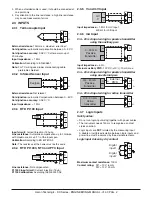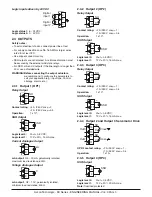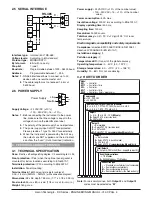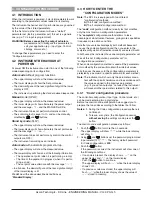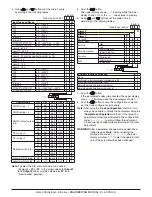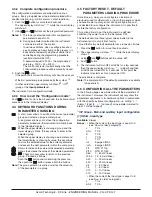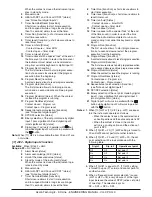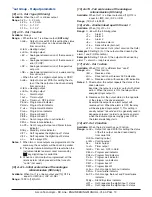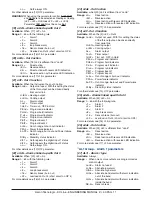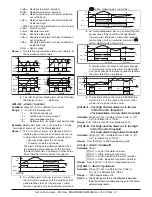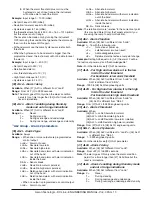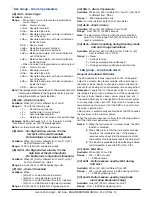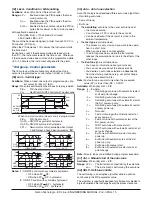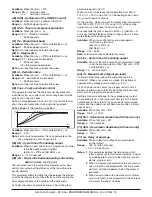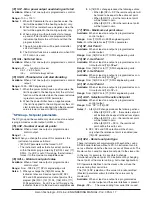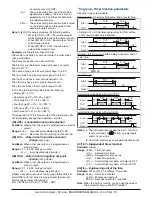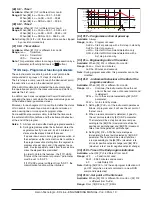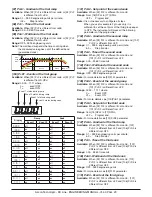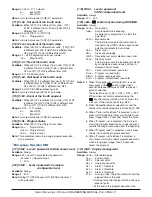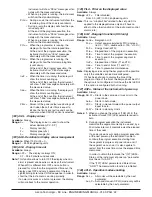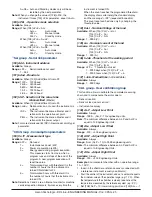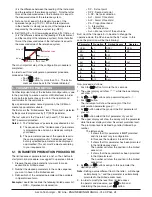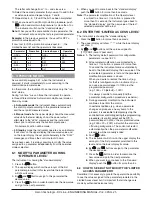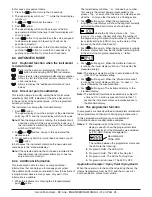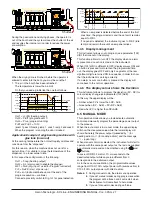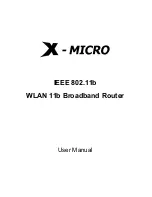
Ascon Tecnologic - KX Line - ENGINEERING MANUAL -Vr.4.0
PAG. 12
LodE = Deviation low alarm (relative)
HidE = Deviation high alarm (relative)
LHdo = Relative band alarm with alarm indication
out of the band
LHdi = Relative band alarm with alarm indication
inside the band
•
When no output is programmed as control output
nonE = Alarm not used
LoAb = Absolute low alarm
HiAb = Absolute high alarm
LHAo = Absolute band alarm with alarm indication
out of the band
LHAi = Absolute band alarm with alarm indication
inside the band
SE.br = Sensor break
Notes: 1.
The relative and deviation alarms are “relative” to
the operative set point value.
LoAb
OUT
AL1
AL1
PV
HAL1
time
HiAb
off
off
off
OUT
AL1
AL1
PV
HAL1
time
off
off
off
ON
ON
ON
ON
LHAb
PV
AL1H
HAL1
time
off
off
off
LHde
OUT
AL1
AL1L
HAL1
PV
AL1H
SP
HAL1
time
OUT
AL1
-AL1L
HAL1
off
off
off
ON
ON
ON
ON
2.
The (SE.br) sensor break alarm will be ON when
the display shows
----
indication.
[28] Ab1 - Alarm 1 function
Available:
When [27] AL1t is different from “nonE”.
Range:
0... 15 with the following rule:
+1 =
Not active at power up.
+2 =
Latched alarm (manual reset)
+4 =
Acknowledgeable alarm
+8 =
Relative alarm not active at set point change
Example:
Setting Ab1 equal to 5 (1+4) the alarm 1 will be
“not active at power up” and “Acknowledgeable”.
Notes: 1.
The “not active at power up” selection allows to
inhibit the alarm function at instrument power up
or when the instrument detects a transfer from:
•
Manual mode (oplo) to auto mode;
•
Stand-by mode to auto mode.
The alarm will be automatically enabled when
the measured value reaches, for the first time,
the alarm threshold ± hysteresis (in other words,
when the initial alarm condition disappears).
PWR ON
AL1
PV
time
off
off
Ab1 = +1
Ab1 = +0
off
off
ON
ON
ON
2.
A “Latched alarm” (manual reset) is an alarm
that will remain active even if the conditions that
generated the alarm no longer persist. Alarm
reset can be done only by an external command
(
button, digital inputs or serial link).
Alarm reset
Alarm reset
AL1
PV
time
off
off
Ab1 = +2
Ab1 = +0
off
off
ON
ON
3.
An “Acknowledgeable” alarm is an alarm that can
be reset even if the conditions that generated
the alarm are still present. Alarm acknowledge
can be done only by an external command (
button, digital inputs or serial link).
Alarm ACK
Alarm ACK
AL1
PV
time
off
off
Ab1 = +4
Ab1 = +0
off
off
off
ON
ON
ON
A “relative alarm not active at set point change”
is an alarm that masks the alarm condition after
a set point change until process variable reaches
the alarm threshold ± hysteresis.
Sp2
Sp1
PV
time
Ab1 = +8
Ab1 = +0
ON
off
off
AL1
off
off
off
AL1
ON
ON
ON
ON
4.
The instrument does not store in EEPROM the
alarm status. For this reason, the alarm status
will be lost if a power down occurs.
[29] AL1L - For High and low alarms, it is the low
limit of the AL1 threshold
- For band alarm, it is low alarm threshold
Available:
When [27] AL1t is different from “nonE” or [27]
AL1t is different from “SE.br”.
Range:
From -1999 to [30] AL1H engineering units.
[30] AL1H - For High and low alarms, it is the high
limit of the AL1 threshold
- For band alarm is high alarm threshold
Available:
When [27] AL1t is different from “nonE” or [27]
AL1t is different from “SE.br”.
Range:
From [29] AL1L to 9999 engineering units.
[31] AL1- Alarm 1 threshold
Available:
When:
[27] AL1t = LoAb - Absolute low alarm
[27] AL1t = HiAb - Absolute high alarm
[27] AL1t = LodE - Deviation low alarm (relative)
[27] AL1t = LidE - Deviation high alarm (relative)
Range:
From [29] AL1L to [30] AL1H engineering units.
[32] HAL1 - Alarm 1 hysteresis
Available:
When [27] AL1t is different from “nonE” or
[27] AL1t is different from “SE.br”.
Range:
1... 9999 engineering units
Notes: 1.
The hysteresis value is the difference between
the Alarm threshold value and the point the Alarm
automatically resets.


